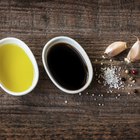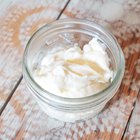Sandwich dressing does more for sandwiches than you might think. Dressing moistens each bite, "cuts" the feel of fat on the palate and helps hold everything together. But be honest: Dressing also makes food taste better, and that's why vinegar and oil is the right dressing for sandwiches of all types.
The beauty of oil and vinegar dressing lies in its versatility. Mayo, ketchup and mustard, for example, can serve the function of oil and vinegar, but don't take as readily to upgrades. You can build thousands of variations off the standard oil-and-vinegar ratio of 1 part vinegar to 3 parts oil. When creating a personalized dressing, start by playing with the vinegar style.
Vinegars and Oils
You can find a vinegar to suit any sandwich. Balsamic, malt, tarragon, apple cider, raspberry, basil, champagne and rosemary are a few examples of the diversity you'll find in vinegar flavors. When experimenting with a new vinegar, go with one that you like. If you stick to a 1-to- ratio of vinegar to oil, you can't go wrong with a vinegar unless you choose one you just don't like.
The same goes with oil. A standard vinaigrette calls for vegetable oil, but you can use just about any oil you find pleasing, such as olive or truffle oil. And there are hundreds of infused oils to choose from – chili, basil and herbes de Provence oil, to name just a few.
Secondary Ingredients
You can add anything to oil and vinegar dressing to help you achieve sandwich nirvana. Garlic, ginger, browned butter, herbs, spices, shallots, avocado, fruit juice, chives, silken tofu, tahini and pomegranate molasses are a few ideas to get the gears turning on your dressing creation.
As a general rule, add these secondary ingredients to taste. You might not find a recipe for every dressing you think of, so you must let your palate guide you with amounts. You can whisk in minced ingredients, such as herbs, garlic and ginger, and puree chunky ingredients, such as avocado and silken tofu.
Dijon Mustard
Dijon adds just a jot of tang to bolster the vinegar while serving a greater purpose: It helps the dressing stay together longer. Homemade oil and vinegar dressing breaks after about 15 minutes, but a teaspoon or so of Dijon, a natural emulsifier, helps bind the fat and water molecules together for a few extra minutes of stability.
Basic Vinaigrette
Mix the base. Add 1 part vinegar and 3 parts oil to a mixing bowl. For one large sandwich, use 1 tablespoon of vinegar and 3 tablespoons of oil. For convenience, add the ingredients to a jar for larger amounts; you only have to shake the jar to mix the dressing, making storing and remixing it easier.
For flavored or infused oil and vinegar, use the same 1-to-3 ratio.
Add flavorings and secondary ingredients. This is when you add flavorings and ingredients that bolster the dressing. Choose flavorings like herbs, spices and aromatics; your favorite spice mix and fruit juices; and/or other ingredients, such as avocado or tofu. For an thick, rich avocado or tofu vinaigrette, add about 1/4 of an avocado or a couple tablespoons of silken tofu.
Blend and emulsify. Here you simply whisk, or, if you used a jar, shake vigorously. For avocado or tofu dressing, use a blender or food processor.
Season and adjust to taste. Add your final adjustments here, starting with coarse salt and freshly ground black pepper to taste. From there, adjust the taste with secondary ingredients as needed. Want a little more acidity? Add a squeeze or two of lemon juice. Want a creamier mouthfeel? Blend in a spoonful or two of mayo or heavy cream.
Whisk and serve. Blend or whisk the dressing a final time.
Related Articles

How to Make Balsamic Vinegar Olive Oil ...

How to Mix Your Own Vinegar & Oil

How to Make Italian Dressing

Substitute for Italian Dressing

How to Store Homemade Salad Dressing

How to Cook Pork Tenderloin in a ...

How to Use Secret of Desert Egyptian Oil
What Can Be Used to Thicken Vinaigrette?
How to Substitute Yogurt for Oil

How to Cook Raw Tuna in Lemon

How Can I Thicken My Italian Dressing?

How to Make a Mayonnaise Facial Mask

Storage Time for Homemade Olive Oil ...

How to Fix Mayo With Broken Emulsion

Oil Substitute in Salads

How to Make Warming Body Oil

How to Make a Lavender Spray for ...

Almond Oil Cooking Substitution

Good Marinade for a Chicken & Steak ...
Easy Taco Soup Recipe
Writer Bio
A.J. Andrews' work has appeared in Food and Wine, Fricote and "BBC Good Food." He lives in Europe where he bakes with wild yeast, milks goats for cheese and prepares for the Court of Master Sommeliers level II exam. Andrews received formal training at Le Cordon Bleu.